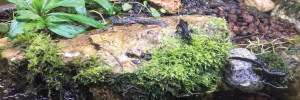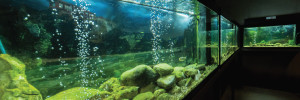Museums
Alberto Parolini Speleology and karst museum
The Museum is located in part of the renovated buildings of the former Burgo Paper Mill, at the entrance to the Caves of Oliero Park. You can visit the museum with your Cave entry ticket.
The Alberto Parolini Speleology and Karst Museum was founded in 1994 by the Federazione Speleologica Veneta and the Municipality of Valstagna to make the huge number of visitors to the nearby Caves of Oliero every year more aware of the problems of managing underground water resources and the importance of research conducted by speleologists, who are able to provide precious natural and environmental data.
But the museum was also designed to be a reference point for Veneto speleologists: a place to share knowledge acquired over years of study and exploration, and from which to also draw new stimuli for continuing research. The museum was created for mostly educational and communication purposes, as the displays inside clearly show. An integrated series including an interactive model, dioramas, aquariums and panels give visitors the most complete snapshot possible of the world of karst, speleology and the Caves of Oliero. A museum like this cannot be just a museum-archive. It’s the kind of place that needs regular updates, as progressions in caving yield new discoveries and information on the karst environment. The new displays also help make communication with the public, mostly schoolkids, more effective and thought-provoking.
Inside the museum are:
Aquariums and amphibian habitat
The wetlands of our territory, amphibians and fish in their natural habitat. An immersive experience in standing and running water environments, to discover the species that inhabit the wetlands. Learning to recognise them, learning where they live, respecting them. Identifying their biological and social habits through large-scale river habitat aquariums and amphibian habitats designed for educational purposes. The presence of a rare and characteristic amphibian walking fish, the axolotl, enhances the understanding of these magical places.
Paper Mill Museum
The Museum is located in part of the renovated former Burgo Paper Mill buildings, at the entrance to the Caves of Oliero Park. You can visit the museum with your Caves entry ticket.
At the Caves of Oliero, you can see the invention that allowed man to harness the power of water to make paper. Go on a voyage of discovery of ancient paper mills up to the dawn of industry and information technology.
The Ethnographic Museum Of The Canal di Brenta
The Museum is in the centre of Valstagna – Valbrenta (Vicenza). 1.7 km from the Caves of Oliero. OPEN FROM SEPTEMBER TO DECEMBER 2020 ONLY SUNDAY (opening times 10-13 and 15-18).
Visitors to the Brenta valley are mainly struck by the two elements that dominate the landscape: the Brenta river (locals call it “a Brenta”, in the feminine version) on whose waters you can see agile canoes weaving deftly in and out, and the mountains, transformed with superhuman effort into terraces designed for tobacco cultivation. Water, timber, stone and tobacco have affected the rhythms of work and daily existence of local people for many centuries.
What now lingers of these centuries-old happenings in people’s memories, in the material culture and in the landscape features? The heritage of words, actions, techniques, individual and collective histories, tools, settlements and other artefacts have been the subject of historical, geographical but predominantly anthropological study conducted in the Municipality of Valstagna and surrounding areas. The Ethnographic Museum of the Canal di Brenta displays some of the results of this work.
Museo diffuso: il Covolo di Butistone
The Museum is in Cismon del Grappa – Valbrenta (Vicenza). 14 km from the Caves of Oliero.
Covolo di Butistone, an ancient military fortress, is a karstic cave roughly 50 m above ground, carved into the limestone rock, containing an internal perennial spring. Situated at the narrowest point in the gorge between Cismon and Primolano, the Covolo di Butistone has always been a natural barrier and defence on the road from Bassano to Trento. In the 19th century (after the Veneto was annexed to the Kingdom of Italy), these functions were delegated to the Tagliata Tombion defensive fort, which was home to a permanent armed garrison. Over the centuries the Covolo passed under the domination of Carrara, the Scaligeri, the Visconti, Venice, Austria and then the Kingdom of Italy. Between 1509 and 1512 during the War of the League of Cambrai it was taken from Venice and became part of the dominion of the House of Austria, becoming an enclave until 1796.
Although it was last in use during the First World War, its strategic function ceased when Napoleon had it dismantled. A key point of the Brenta valley (together with the La Scala Fort and the Enego Bastion), the Covolo was a military and customs checkpoint for the entire valley and was only accessed via a winch system that raised and lowered a special basket to load people and goods. The “Covolo di Butistone and Valley Defences Museum” consists of the actual museum in Via Roma, in the former Municipal Building and other fortifications in the Municipality built before the Great War (Tagliata di Primolano and Tagliata Tombion). Its purpose is to provide a cultural centre open to the territory covering history, art and archaeology and to organise cultural events linked to the local history and traditions of the Brenta valley.
Carpanè Tobacco Museum
The Museum is in Carpanè – Valbrenta (Vicenza). 1.7 km from the Caves of Oliero.
Tobacco cultivation played an essential role in the Brenta valley until the last century. Sowing began in February in small greenhouses near people’s homes. It was the women who did the sowing and then, around May, transplanted seedlings onto the terraces where the ground had been prepared. The ground was divided into even, equidistant squares with the teeth of a rake and planted with the best plants, which were then treated with fertiliser, topped (flowers were pinched off to strengthen the plant) and pinched off, as in the lower leaves were removed under the watchful eye of officials, so they could not be spirited away for smuggling). In late August, 6 or 7 leaves per plant would be harvested, packed and carried home to the loft where they would be left to dry. They were then hung out to dry completely on racks in grain warehouses where they stayed until December, being turned regularly to prevent rotting. Then the best leaves were selected and packed into bunches and delivered to the warehouses.
This painstaking labour led to the creation of Campesano and Nostrano del Brenta cigars, both of which are highly prized. Nowadays some terraces have been abandoned, and others converted for other crops – olives, vines and vegetables – and thus saved from decline. Their role in water management is essential for the stability of the mountain slopes, holding back both landslides and rain wash-off, but they also continue to make an important environmental contribution as a habitat for both wild plants and animals. The dry-stone walls can actually accumulate considerable heat during daylight hours which they then release overnight. Small plants, like mallow, wall-rue, pennywort or biting stone crop, to name the most common and recognisable, thrive in this situation. In terms of fauna, the overlapping stones make the perfect home for pill woodlice, millipedes, snails, spiders and reptiles, starting with the common wall lizard (Podarcis muralis).



